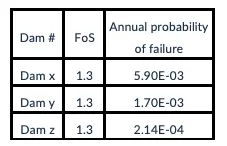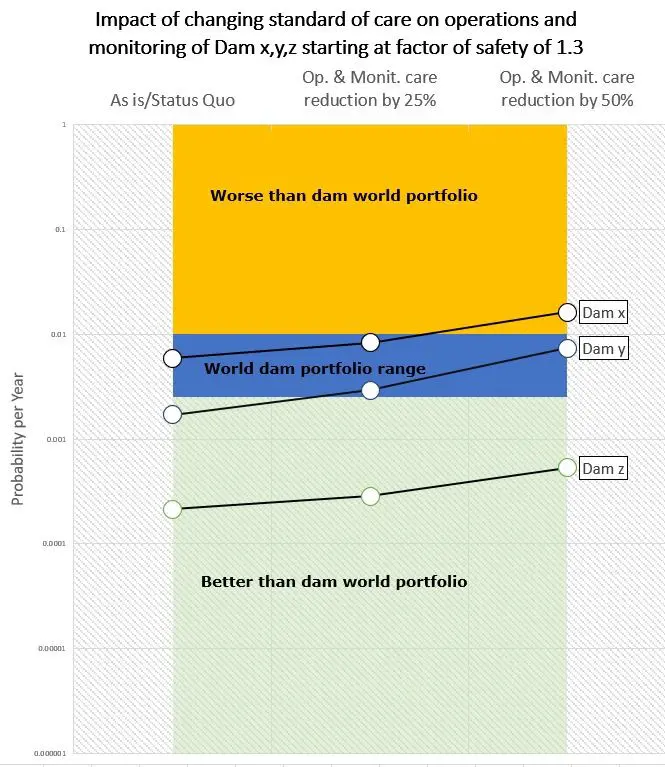We can quantify the impact of standard of care on dam survivability by using ORE2_Tailings™.
In this blogpost, we discuss three dams, which we will call Dam X, Dam Y and Dam Z. Their design was identical with an initial factor of safety of 1.3. In addition, they had similar quality assurance and quality control, construction method, systemic approach, efforts and uncertainties consideration.
Various small mishaps occurred throughout their history. Some repairs were completed, under different contracts and quality control and at different times. Dam X and Dam Y were in rather poor shape at the time of our analysis, whereas Dam Z was still performing well.
ORE2_Tailings Probabilities of Failure of the Three Dams
Due to those differences, when we performed the ORE2_Tailings assessment, the dams came out with different probabilities of failure, despite the initial identical factor of safety.
The fact that identical factors of safety may lead to over one order of magnitude difference in terms of probability of failure is not a surprise. We demonstrated this in our 2020 book Tailings Dam Management for the Twenty-First Century.
The client was impressed by these differences and asked us what would be the effect of reducing the operations (inspections, audits, etc.) and monitoring standard of care on these dams.
Effect of Releasing the Standard of Care on the Three Dams
Thus, we used the results above as the status quo case and built two scenarios: a reduction of 25% and then 50% of the standard of care for operations (inspections, audits, etc.) and monitoring.
The figure below displays the results.
As can be seen and as expected, the reduction of standard of care increases the probability of failure of each dam. As a matter of fact, the larger the reduction, the higher the probability.
The impact of standard of care on dam survivability becomes evident. In addition, if the client wanted, we could even back-calculate the corresponding reduction of the factor of safety. Thus, it is possible to design a level of care that keeps a dam’s probability of failure within a certain range.
Standard of Care Reduction vs. Benchmarking
It is then very interesting to see how the three dams behave with respect to the last century of worldwide performance benchmark, which is part of ORE2_Tailings.
As the standard of care changes:
- The best of the dams, Dam Z, remains in an area better than the worldwide dam portfolio performance in all three scenarios.
- With 25% reduction in standard of care, Dam Y, which was in the “better than worldwide” area in the status quo case, becomes an “average dam.”
- At 50% reduction of care, Dam Y reaches the higher bound of the “average dam” range.
- Dam X starts in the top half of the average worldwide range in the status quo case. As the standard of care release reaches 25−50%, the dam emerges in the range of “worse than the world portfolio” area. Because of that shift, the position of the owner may become difficult to defend within the framework of the Global Industry Standard on Tailings Management.
The Impact of Standard of Care on Dam Survivability
The impact of standard of care on dam survivability can be evaluated quantitatively. It is multifaceted because it increases the probability of failure and changes the benchmarking of any structure. Changing the probability of failure alters the risks generated by a dam. With this information, an owner can decide if it is worth rebuilding that broken inclinometer or embarking in that new monitoring campaign.
This is an illustration of risk-informed decision-making at its finest. As a result, we get more transparency, clarity and awareness of the effects of our decisions.


